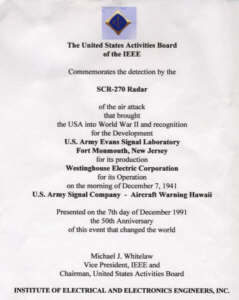The History of InfoAge Science & History Museums
World War II & RadarSCR-270 Radar Spots Japanese Planes 50 minutes before the attack. The untrained officer in Command Information Center does not act upon the information. Command Failure results in greater loss of lives and ships.

Plaque presented by IEEE to Camp Evans for developing, Westinghouse for building & Opana station crew for detecting the enemy planes with radar on December 7, 1941
Signal Corps RADAR
Ready and Operating
December 7, 1941
by Fred Carl
First Lieutenant Harold Zahl had one burning worry. “Had our early-warning radar failed?” He was a physicist and for years, under great secrecy, was part of a group working to prevent such a surprise attack. How could the Japanese Empire achieve complete surprise? After a Japanese flyer radioed the now-famous Tora-Tora-Tora, two thousand Americans were killed and the American Pacific fleet was heavily damaged. Six of America’s best early warning radar sets, each capable of detecting bombers 150 miles away, had been sent to the Hawaiian Islands to protect the Navy Base.

The Pearl Harbor SCR-270 RADAR Unit Preserved at the Historical Electronics Museum
“If our radar had not given a warning because of break down, or just ineffectiveness, surely part of the finger of blame would point at our group.” Colonel Blair, Harold Zahl and the visionaries of Fort Monmouth realized at the close of WWI that the next war would not come from the sea, but from the air. The days in which America was protected by the vastness of the oceans were ending. As aircraft technology improved, they would be able to reach America. A way had to be found to detect enemy aircraft and send planes to destroy the attackers.
The development work was difficult. There was no funding. Command did not realize the advances in aircraft development would accelerate. Also, the electronics industry was new, and components were not available for this unique challenge. After working for many years at Fort Monmouth, the work was moved to isolated Sandy Hook. German spies were suspected of observing the work at the main post. Everything had to be developed from scratch. Harold Zahl even hands made the first 100 special radar tubes he designed for the new radar sets. Had one of his tubes failed?

The Pearl Harbor SCR-270 RADAR Unit Preserved at the Historical Electronics Museum
For days there was no word of what had gone wrong in Hawaii. Harold Zahl waited for “the damning words which might say that our new early-warning system had not worked and the Japanese had sneaked in while Signal Corps electronics had failed in its great hour of test and crisis.”
Finally, a call from Washington from Rodger B. Colton would bring an end to the worry. The new radar had worked! Harold Zahl and the radar engineers were elated, “we cheered, vigorously shook hands and slapped backs.” Two Signalmen, Joe Lockard and George Elliott, operating an SCR-270 radar set, had seen the Japanese planes approaching as early as 7:02 A.M. They checked their equipment. They had not seen such a large signal before. At 7:20 A.M. they telephoned the sighting to the Information Center. The information was not acted upon and the first bombs fell at 7:55 A.M. Over fifty minutes were lost to prepare to meet the enemy with guns ready. Victory could have been taken from the attackers and American ships protected. A Japanese flyer would not have yelled Tora-Tora-Tora.

The radar pioneers in front of the Marconi hotel during WWII. Left to right in front row: #2 Harold Zahl, made vacuum tubes VT158 for AN/TPS3 radar #4 Jack Slattery, designer of SCR268 fire control radar #5 Oscar Maier, commanding officer #6 Paul Watson, technical director, John Marchetti’s boss Mr. Marchetti is the last person in third row whose head is even with the white trim on porch (photo and identification courtesy of Mr. John Marchetti)
They worry that the new radar had failed was over and unfounded. If the enemy can attack Hawaii would they now attack the Panama Canal, Washington, or the West Coast? Camp Evans personnel were sent immediately to make sure the Panama Canal and other key locations were protected. Months before the Pearl Harbor attack the radar group even relocated their laboratory from Sandy Hook to the old Marconi Wireless Station in Wall to be safe from Nazi submarine attacks.
The war years would bring many challenges. The radar sets sent to Hawaii would be improved and updated to prevent enemy jamming and to work with new weapon systems. The next-generation radar sets were in development. The Camp Evans engineers were working with MIT to get the prototype ready to meet battle conditions the very week the Japanese attacked. The radar would be called upon to help destroy a new Nazi weapon later used in Europe, the V-2 rocket.
At the end of W.W. II the secret radar was given as a “major reason for victory“. The radar visionaries who realized radar was needed long before war arrived now saw the new threat for America, the rocket. Just as at the end of W.W. I the plane had limited abilities, at the end of W.W. II rocket technology was just beginning. Rockets could reach beyond the ionosphere and radar could not. In 1945 rockets could not cross the oceans, but the day would come when they could, carrying the new atomic bomb. Just as after W.W. I the Camp Evans radar engineers did not wait for orders and began preparing to protect America with advanced technology.
See how these engineers who developed cutting edge electronics to protect our nation, in the 1930s-1940s, opened space-age communications and gave birth to the science of radar astronomy with Project Diana.
Page created December 2, 2001
We Need Your Help! Volunteer with Us.
Join our mission to preserve historic Camp Evans and teach the public about science and history.
Sign up to join our team of volunteers and start on your own mission today.
InfoAge Science & History Museums
2201 Marconi Road
Wall, NJ 07719
Tel: 732-280-3000
info@infoage.org
webmaster@infoage.org
